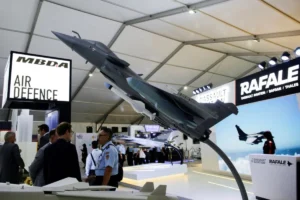Indonesia’s Rafale Jet Deal Under Spotlight Amidst Lessons from India-Pakistan Aerial Clash

Introduction: A High-Stakes Defense Investment
Indonesia made global headlines in early 2022 when it inked a multi-billion-dollar agreement to acquire 42 Dassault Rafale fighter jets from France. The deal, worth over $8.1 billion, was touted as a transformative move to modernize the Indonesian Air Force (TNI-AU). However, in light of the recent India-Pakistan aerial clash in 2025, military experts and defense analysts are now reassessing the strategic value and combat readiness of the Rafale platform in high-tension scenarios.
Why Rafale? Understanding Indonesia’s Choice

Indonesia selected the Rafale for its proven multirole capabilities, including air superiority, precision strike, and maritime surveillance. Its omnirole flexibility, advanced AESA radar, and capability to carry nuclear and conventional weapons made it a natural choice over competing American and Russian jets.
Jakarta was also influenced by the jet’s successful deployments in the Middle East, Afghanistan, and more recently, India’s 2020 Balakot airstrikes. The French government’s full transfer of technology clause and favorable financing terms were additional incentives.
India-Pakistan Aerial Clash: Lessons Revisited
In May 2025, tensions between India and Pakistan flared again, culminating in a short-lived but intense aerial engagement. India’s Rafale fleet, part of the Western Air Command, was deployed alongside Sukhoi-30MKIs and Tejas Mk1A aircraft in a coordinated response.
While the full operational details remain classified, early assessments indicate that Rafales played a limited but strategic role, focusing on deep surveillance and mid-air command functions rather than direct dogfighting. Notably, no confirmed aerial kills were attributed to Rafales, leading some to question their cost-effectiveness in traditional air combat.
Strategic Value vs. Cost: Is Rafale Worth the Price?

Critics in both India and Indonesia argue that the Rafale’s high unit cost—estimated at $120–130 million per aircraft—demands clear tactical advantages. However, the recent aerial skirmish showed that domestically produced aircraft, like India’s Tejas, held their own in close combat scenarios.
This raises a fundamental question for Indonesia: Are Rafales an overinvestment when equally capable, lower-cost alternatives exist? Additionally, the operational and maintenance costs of the Rafale are significantly higher than its competitors, such as the F-16 Block 70 or even the Eurofighter Typhoon.
Geopolitical Reactions and Regional Implications
Indonesia’s acquisition of Rafales also comes at a time of rising regional tensions in the South China Sea. The presence of a high-end fighter fleet could bolster deterrence, but it also risks escalating arms races with neighbors like Vietnam, Malaysia, and China.
Moreover, with India’s experience highlighting the mixed utility of Rafales in real-world conflicts, Southeast Asian nations are watching closely to see whether Jakarta’s investment yields strategic dividends or burdens the economy.
Defense Experts Weigh In
Defense analyst Air Marshal (Retd.) Anil Chopra, commenting on the recent clash, remarked:
“The Rafale is an exceptional platform, but in asymmetrical or short-duration conflicts, it may not always be the first mover. Cost-effective multirole jets often shoulder the brunt of frontline operations.”
Similarly, Indonesian security commentator Andi Widjaja stated:
“Jakarta must ensure that our defense investments deliver not just prestige, but operational readiness. We need aircraft that can dominate both in peacetime patrol and wartime confrontation.”
Conclusion: Time to Rethink Defense Priorities?
Indonesia’s Rafale deal remains a landmark in its military modernization journey. However, the India-Pakistan aerial skirmish of 2025 offers a real-world case study that questions the practical role of such high-cost jets in limited regional conflicts. As the first batch of Rafales is expected to arrive in Indonesia by 2026, it remains to be seen whether these jets will live up to their reputation—or become symbols of costly ambition.

Leave a Reply